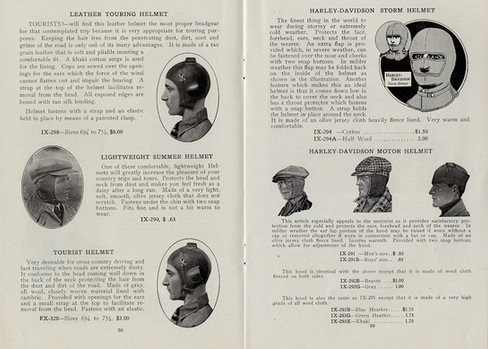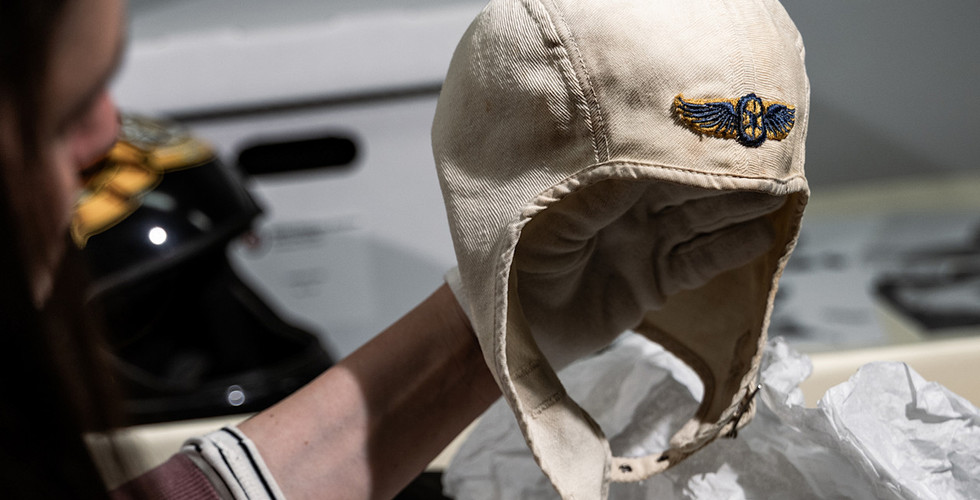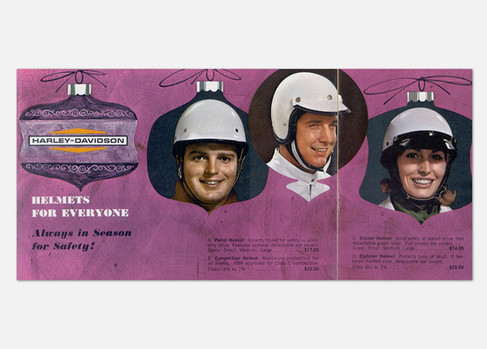HELMETS THROUGH HISTORY
- 3 hours ago
- 2 min read

For much of their history, motorcycle helmets have been as much about self-expression as protection—and the earliest helmets didn’t provide much of the latter.
Back when football players wore soft leather helmets, motorcycles were just starting to dot the American countryside and city streets. Speeds were lower and there was no traffic density. Those first motorcycle “helmets” were made of thin leather or cloth, and primarily succeeded in keeping the wearer’s hair in place.

Through the 1910s, several different and distinct headwear items could be purchased from the Harley-Davidson Accessories catalogue, each with a different purpose. Among them were the "Heather Jumbo Knit Cap" (75 cents), the "Aeroplane Cap" ($1.50), as well as a unique piece called the "Tourist Hood" ($2.50), an item meant for "cross country driving and fast traveling" that was to keep dust and dirt out of one's hair.
For many of the early years, fur-lined soft helmets were offered for cold weather riding, and a version of a leather football-style helmet was sold, though they were mostly used by racers.
Some of the "helmets" that became popular with riders in the 1930s and 40s were little more than satin skullcaps that were stylishly coloured and patterned, with the tried and true Bar & Shield logo on the front. And, of course, there was the classic motorcycle cap that became synonymous with riders, the kind that Marlon Brando wore in "The Wild One." Caps of that style were available for many years from Harley-Davidson ("Classy Caps" in the 1937 accessory catalogue), and later versions were available with the "winged wheel" logo, winged Bar & Shield and many other emblems.
BY THE 1950S AND ‘60S, HELMETS AS WE THINK OF THEM TODAY WERE TAKING SHAPE, FIRMLY ESTABLISHED AS SAFETY GEAR. BY 1971, MULTIPLE COLORS WERE OFFERED, BUT THE STYLES REMAINED LIMITED. TODAY, THE VARIETY CAN FEEL ALMOST LIMITLESS.
By the 1950s and ’60s, helmets as we think of them today were taking shape, firmly established as safety gear. In the first years that Harley-Davidson offered a hard-shell helmet, two of three total choices were aimed specifically at police officers and racers; H-D catalogs the gear was often called “safety helmets.”
For the next 13 years, self-expression took a back seat to safety: all H-D helmets came in white. By 1971, multiple colors were offered, but the styles remained limited. Today, the variety can feel almost limitless, especially when you consider the role that custom designs and personal style play. But even in the past, color, pattern, patches and other customizations were applied to headwear to stand out—whether to aid with identification on the race track, demanding attention in a crowd, or simply letting people know a little about who you are. From H-D produced gear to truly custom creations, helmets and their early predecessors are an eye-catching part of the Harley-Davidson Archives.
Article courtesy of The Harley-Davidson Museum
Photos by Josh Kurpius Archival photos courtesy of H-D Museum



































Comments